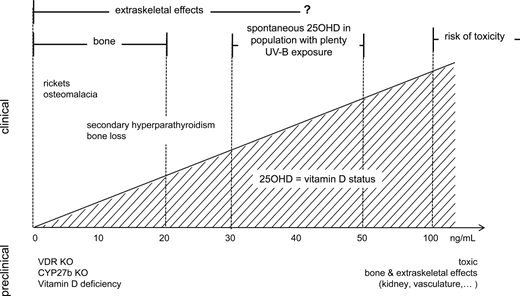tankasnowgod
Member
- Joined
- Jan 25, 2014
- Messages
- 8,131
I got interested in supplementing higher doses of vitamin D recently based on the threads discussing the Coimbra Protocol, which uses Vitamin D at doses of 40,000 to 300,000 IU a day to treat Auto Immune diseases. That protocol reminded me of seeing a book by Jeff Bowles who experimented with doses of fairly high daily doses of Vitamin D himself, ranging from 25,000 to 100,000 IU over the course of a year. One key thing to note in his protocol- he balanced every 10,000 IU of D with K2 (he was using Life Extension Super K) which had (at the time) 1,000 mcg of MK-4 and 100 mcg of MK-7 (now, Super K has 200 mcg of MK-7), and also recommended Magnesium.
Over a 10-12 month period, he noted some major improvements-
Cracking joints and hips resolved
Toenail fungus was cured, and nails became normal
Rough skin on feet became smooth
Ganglion Cysts Shrunk
A Bone Spur in his elbow dissapeared
He lost about 20 pounds without and conscious effort to lose weight
The reviews on his book, mostly positive, are in the hundreds now. He also maintains a blog where he talks about high vitamin D intake, among other "health hacks"- Jeff T Bowles
I was interested in the idea of higher D (I had seen a lot of benefits from supplementing D already), and gave it a try, but didn't really commit to it, and got disinterested after a few weeks.
Anyway, I have been supplementing less D over time (I don't think I supplemented ANY the past two summers). I have been supplementing K2 and Magnesium for years now, so thought I might up Vitamin D from the 5,000 IU five days a week I was taking to 25,000 IU a day. It's only been a week, but I have noticed a significant increase in energy, mood, and focus. I'm very curious about the effects on weight loss and skin, and plan to keep this level up for at least 6 months, maybe even upping it.
As far as safety and toxicity levels, I think the K2 and Magnesium will do a great job managing those, and I do plan to test serum levels.
Peat has mentioned that the body can make 10,000- 15,000 IU of Vitamin D from half an hour exposure to sunlight, so supplementing at those levels shouldn't be an issue. I think the Vitamin D council stated that 25,000 IU a day could be made from sun exposure in a day.
Beyond that, the following study draws the conclusion that Vitamin D can be supplemented at levels of 60,000 IU for months or years with no signs of toxicity- https://www.sciencedirect.com/science/article/abs/pii/S0960076016303569
Here, Ray Peat suggests that Vitamin D is parallel to Thryoid-
And interestingly, in this clip, Peat suggests that Vitamin D issues exist when too little calcium (and magnesium) is in the diet-
Peat on Vitamin D Deficiency-
So, I plan on updating my progress on this level of D. Also of note, I am doing Inclined Bed Therapy, and a lot of the testimonials overlap with some of the testimonials I have heard on higher dose D Supplementation. It would be really exciting if I get positive results compounded because of this.
Over a 10-12 month period, he noted some major improvements-
Cracking joints and hips resolved
Toenail fungus was cured, and nails became normal
Rough skin on feet became smooth
Ganglion Cysts Shrunk
A Bone Spur in his elbow dissapeared
He lost about 20 pounds without and conscious effort to lose weight
The reviews on his book, mostly positive, are in the hundreds now. He also maintains a blog where he talks about high vitamin D intake, among other "health hacks"- Jeff T Bowles
I was interested in the idea of higher D (I had seen a lot of benefits from supplementing D already), and gave it a try, but didn't really commit to it, and got disinterested after a few weeks.
Anyway, I have been supplementing less D over time (I don't think I supplemented ANY the past two summers). I have been supplementing K2 and Magnesium for years now, so thought I might up Vitamin D from the 5,000 IU five days a week I was taking to 25,000 IU a day. It's only been a week, but I have noticed a significant increase in energy, mood, and focus. I'm very curious about the effects on weight loss and skin, and plan to keep this level up for at least 6 months, maybe even upping it.
As far as safety and toxicity levels, I think the K2 and Magnesium will do a great job managing those, and I do plan to test serum levels.
Peat has mentioned that the body can make 10,000- 15,000 IU of Vitamin D from half an hour exposure to sunlight, so supplementing at those levels shouldn't be an issue. I think the Vitamin D council stated that 25,000 IU a day could be made from sun exposure in a day.
Beyond that, the following study draws the conclusion that Vitamin D can be supplemented at levels of 60,000 IU for months or years with no signs of toxicity- https://www.sciencedirect.com/science/article/abs/pii/S0960076016303569
Here, Ray Peat suggests that Vitamin D is parallel to Thryoid-
And interestingly, in this clip, Peat suggests that Vitamin D issues exist when too little calcium (and magnesium) is in the diet-
Peat on Vitamin D Deficiency-
So, I plan on updating my progress on this level of D. Also of note, I am doing Inclined Bed Therapy, and a lot of the testimonials overlap with some of the testimonials I have heard on higher dose D Supplementation. It would be really exciting if I get positive results compounded because of this.
Last edited:

